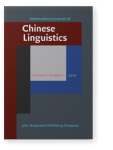Vol. 6:1 (2019) ► pp.76–118
On embedded contrastive focus in Mandarin Chinese
This article investigates the previously undocumented focus-sensitiveness of certain scope-bearing expressions in Mandarin, and argues that the syntactic effects of this property should be accommodated by a structure that involves multiple dependencies and inherited dependencies. At the empirical side, it is shown that in Mandarin, certain quantificational expressions as well as typical focusing adverbs have to occur at positions where they (i) c‑command and (ii) be as close as possible to the contrastive foci that they associate with. The similarity to the typical association-with-focus configurations is captured under a unified Agree analysis that incorporated previous variable-adjunction-site analysis for focusing particles in German, while the additional dependencies in these structures are accounted for by multiple Agree and feature inheritance. This analysis is compared with some alternative approaches, which do not have equal empirical coverage or require more complex theoretical assumptions.
Article outline
- 1.Introduction
- 2.The association-with-focus effects of quantifiers
- 2.1Truth conditions
- 2.2Continuation with inferences that involve substituted elements in the focus positions
- 3.The syntax-semantics correspondence effects in Mandarin Chinese
- 3.1Mandarin counterparts of Rooth’s and Krifka’s data
- 3.2Movement of quantified DPs objects in Mandarin
- 4.The structure of quantificational expressions in Mandarin
- 4.1Theoretical assumptions
- 4.2The Agree structure of quantificational constructions
- 4.2.1Quantificational adverb constructions
- 4.2.2Quantificational DP constructions
- 5.Comparisons with alternative approaches
- 5.1The focus-sensitiveness of QuEs is a purely pragmatic phenomenon
- 5.2Focus-background partition with across-the-board obligatory defocusing movement
- 5.2.1Empirical and theoretical issues of the defocusing movement approach
- 5.2.2How the variable-adjunction-site/landing-site approach can resolve these issues
- 6.A note on real defocusing movements
- 7.The focus-sensitiveness of the lian…dou ‘even’ construction
- 8.Conclusion
- Acknowledgements
- Notes
-
References
